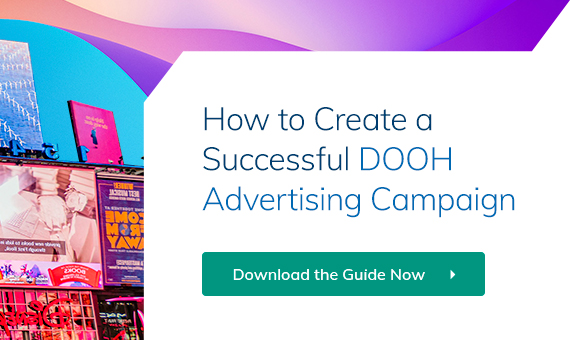A digital Out of Home advertising campaign – or DOOH campaign for short – can be extremely effective for SMBs.
The figures speak for themselves.
At a time when only 12% of online ads ever get looked at (and only 4% for more than a second), SMBs need a marketing strategy they can be sure people will take notice of.
DOOH advertising delivers on this front in no uncertain terms.
A study by Nielsen in association with the Out of Home Advertising Association of America (OAAA) finds that nearly two-thirds (62%) of consumers had noticed digital billboards in the past month, and 38% in the past week. What’s more, 50% of those who’ve noticed digital billboards report high engagement – that is, noticing them “all” or “most” of the time.

(Image source: youtube.com)
This engagement drives action.
The study went on to reveal that 65% of digital billboard viewers engaged in at least one action after seeing the ad – be it visiting a website (34%), visiting a store (32%), visiting the brand’s social media site (23%), or recommending the product or brand to someone else (18%).
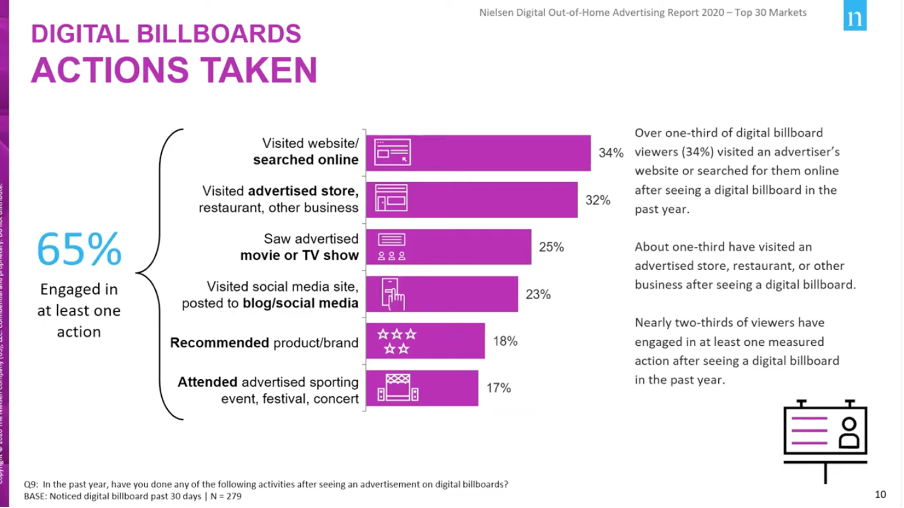
(Image source: youtube.com)
For SMBs with a bricks-and-mortar presence on the high street, the findings are once again extremely favorable.
The study found that of the 52% of consumers who noticed a digital billboard with directions to a retail location, 57% immediately visited that location, where 93% made a purchase.

(Image source: youtube.com)
And this is just the effects of digital billboard advertising.
Today, DOOH advertising media comes in all shapes and sizes. There’s street-level DOOH advertising on the likes of urban panels and bus stations – which 49% of people notice each month. Then there’s place-based DOOH advertising at gyms, malls, stores, cinemas, restaurants, bars, night clubs, entertainment venues, and sports arenas, which 62% of people notice.
And, once again, place-based digital Out of Home advertising that features directions to a nearby retail location drives impressive footfall and sales lift for SMBs.
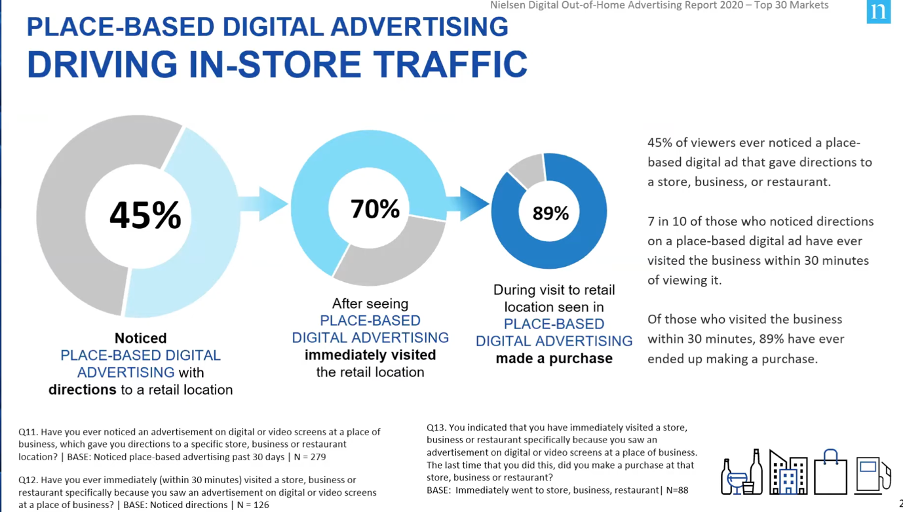
(Image source: youtube.com)
However, if you’re an SMB and want to realize all these fantastic benefits of Out of Home digital advertising for yourself, it’s crucial to create a solid DOOH strategy to maximize your ROI.
To make sure your digital Out of Home efforts reach your target audience and achieve all your campaign objectives, we’ve put together this quick guide to help you design a DOOH ad campaign strategy that gets results.
Step 1 – Define Your Goal
Every advertising campaign needs a defined goal to work towards from the outset – and a DOOH marketing strategy is no different.
You may be trying to increase brand awareness, promote a specific product, drive footfall to your store, increase visits to your website or social media account, encourage app downloads or some other form of mobile action. Whatever it is, it’s important you are clear about the purpose of your advertising campaign from the outset so you can keep focused on your goal, and so you know how to measure success.
Step 2 – Define Your Target Audience
Very few brands have something for everyone – and even fewer professional marketing campaigns attempt to be all things to all people.
The reason is when you try to speak to too many people at once, your message – almost by necessity – becomes diluted.
Instead, you must choose a target audience and speak to them directly – and your target audience looks a lot like your ideal customer.
So, think hard about who your ideal customer is. Think about their demographic – are they young people, under 40, over 60? Are they men, women? Are they white- or blue-collar workers? Students? Do they have families? What is their income? What are their interests? What does their daily routine look like?
By answering these questions, you build up a detailed buyer persona – which ideally should look something like this:
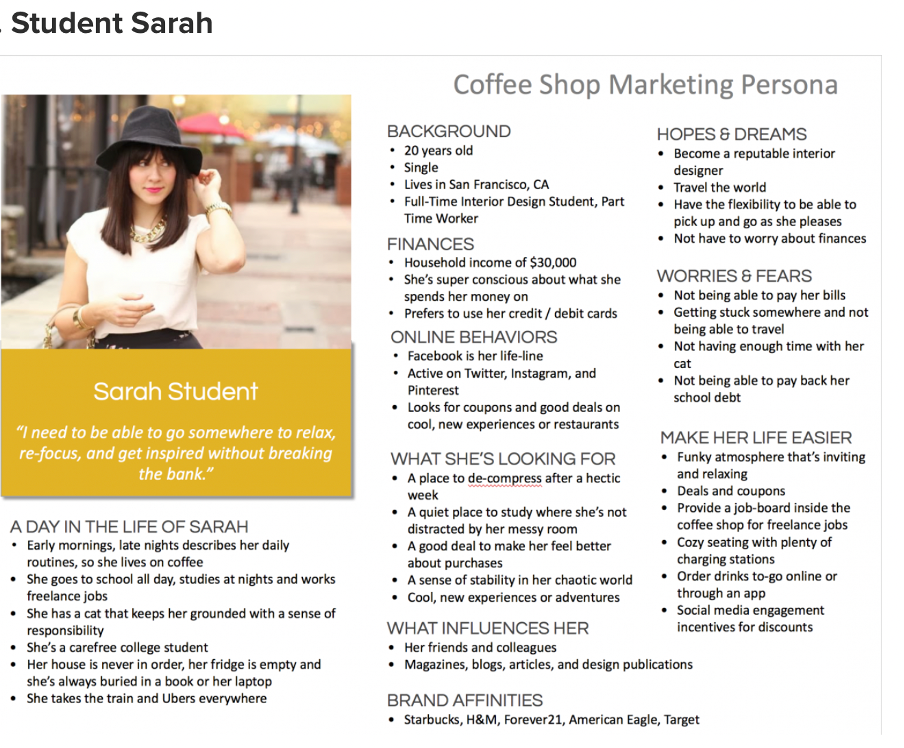
(Image source: impactplus.com)
Armed with this detailed information, you can now start to think how best to craft a message that will speak directly to your target audience in a specific place and moment and time – which leads us nicely onto the next step.
Step 3 – Locate Your Target Audience in Relation to DOOH Screens
Yes, using powerful programmatic DOOH (pDOOH) platforms like The Neuron, you really can pinpoint exactly where your target audiences are going to be in relation to DOOH screens at different points throughout the day.
pDOOH platforms utilize anonymized location data (plus data from other sources) to build a detailed picture of where different demographics spend their time throughout the day, as well as their daily routines. With this information, they can determine which audiences get exposed to which ads showing on which DOOH screens.
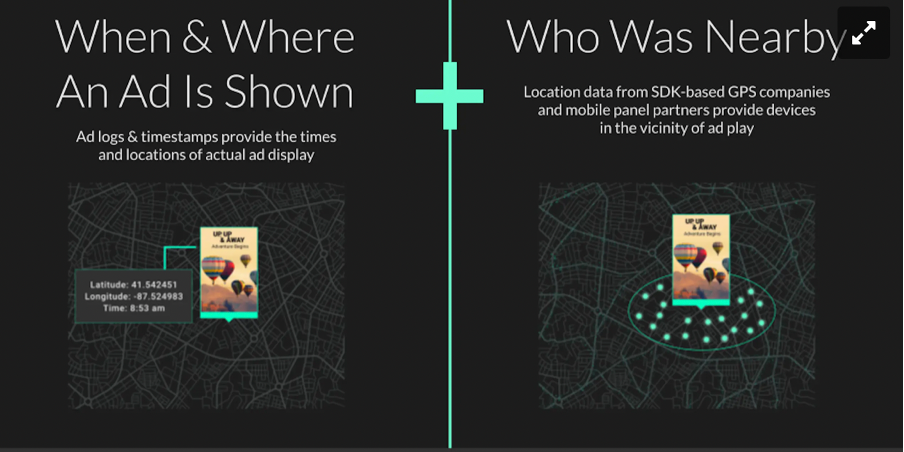
(Image source: thedrum.com)
This information all feeds directly into the pDOOH platform – meaning you can hand select the DOOH screens that your target audience will most likely see, and then show your ads on those screens on the days and times they are most likely to see them.
This is crucial data for your DOOH strategy.
Step 4 – Produce Your Creative
Now that you’ve defined your goals and identified and located your target audience, you’re ready to start producing your ad.
When it comes to DOOH advertising, there are some crucial best practices to follow.
These are:
- Keep your message short and sweet– many DOOH viewings last only a few seconds as people whizz past in cars, buses, motorbikes, and trains. As such, about seven words or fewer is a good rule of thumb.
- Choose readable fonts, bold colors, and single images– again, it’s crucial that viewers can process your ad quickly, and bright, readable fonts with just one image ensures they can.
- Target localities– the great thing about pDOOH advertising is that you can add contextual relevancy to your campaigns by tailoring each ad based on its location. This can be particularly effective if you incorporate a little humor – like this ad promoting The Grinch movie in New York.
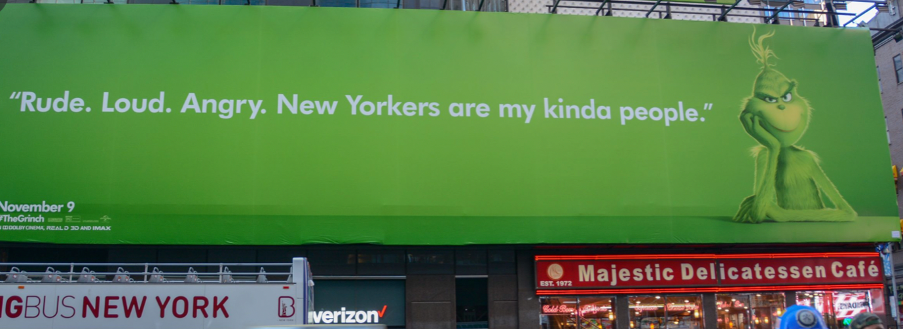
(Image source: google.com)
Read more: 5 Top Design Tips for a Successful DOOH Campaign
As an SMB, you may be concerned that you don’t have the in-house skills or budget to create outstanding creative.
Fear not. At The Neuron, we have completely democratized the creative production process with our 100% free to use DOOH Design Studio.
The Studio comes with hundreds of ready-to-use vertical-specific templates that have all been designed by digital out of home advertising design experts. All you need to do is pick your template, add your logo, customize the message – and voila, you have a professional looking DOOH ad you can use straight away.
Step 5 – Purchase Your Ad Space on a pDOOH Platform, then Track and Optimize
Your campaign is now ready to launch.
The final step, therefore, is to log on to a programmatic DOOH platform and set your ads live.
For example, with The Neuron, you simply upload your creative, select the screen (or screens) where you want your ads to display, and then define your criteria for when they go live – such as target demographics, number of impressions, time of day, day of week, and even things like weather conditions, temperature, pollen count, and traffic conditions.
This is all done in a few simple clicks – and once your ad is live, you can then view up-to-the-minute analytics on how it is performing so you can optimize in real-time.
Read more: How to Measure OOH Advertising
Your DOOH strategy is now ready for launch.
Don’t waste any time. Try The Neuron today.

